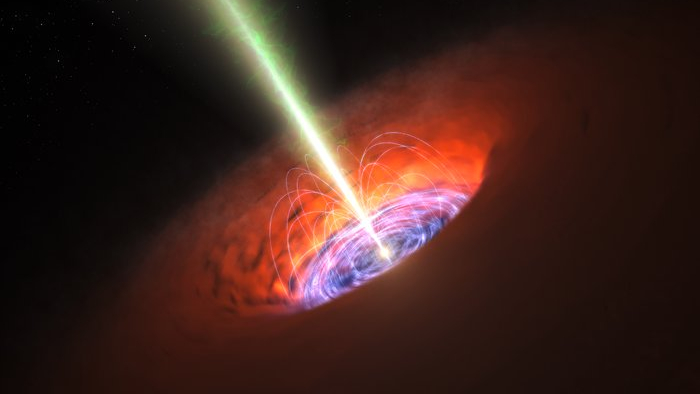Astronomers discover thousands of active red galaxy hearts with powerful radio signals
A fraction of red quasars have been shown to be young active galaxies smothered in cosmic dust.

Red quasars filled with cosmic dust produce stronger radio emissions than their bluer, dust-free counterparts — and these phenomena, scientists say, could represent a generation of younger active galaxies with supermassive black holes that only recently switched into overdrive.
"There are still many unanswered questions surrounding red quasars, such as whether black hole winds or radio jets are ultimately responsible for this enhanced radio emission," Victoria Fawcett, lead author of a new study on this finding and an astronomer at Newcastle University in the United Kingdom, said in a statement.
However, Fawcett believes we're getting close to the brink of fully understanding the nature of these incredible marvels.
Related: 1st black hole imaged by humanity is confirmed to be spinning, study finds
A quasar is the powerful central region of an active galaxy, and is driven by a supermassive black hole that is being fed huge amounts of matter. That matter forms a disk of gas around the black hole, known as an accretion disk, that reaches millions of degrees and releases fierce radiation winds. Meanwhile, magnetically collimated jets launch outwards from the disk.
Quasars are so bright that they vastly outshine the collective starlight of their host galaxies and can therefore be seen across the universe.
Most quasars appear blue, a hue caused by optical and ultraviolet emissions from the hot accretion disk. However, a fraction appears red instead. To reach their conclusions about those red quasars, Fawcett and fellow researchers sampled approximately 35,000 quasars observed by DESI, the Dark Energy Spectroscopic Instrument on the Mayall Telescope at Kitt Peak National Observatory in Arizona.
Breaking space news, the latest updates on rocket launches, skywatching events and more!
Of this collection, Fawcett’s group found 3,038 to be red quasars. Cross-referencing with radio astronomy data from the LOFAR (Low Frequency Array) Two-meter Sky Survey (LoTSS), they confirmed that most of these red ones are also emitting strongly in radio waves.
The redness comes from the presence of dust, which absorbs shorter, bluer wavelengths but allows longer, redder wavelengths to pass. The red quasars must therefore be smothered in cosmic dust, formed of tiny grains just microns in size.
"It was really exciting to see the amazing quality of the DESI data and to discover thousands of these previously rare red quasars," Fawcett said. "I think this is the strongest evidence so far that red quasars are a key element in how galaxies evolve."
The red quasars seem to be radiating more strongly in radio waves than the blue quasars because of interactions between outflows of radiation pouring from a quasar and the surrounding curtains of dust. As the outflows slam into the dust, they excite molecules within the dust to prompt the emission of radio waves. Over time, the outflows, driven by the energy of a supermassive black hole hungrily feeding on vast amounts of matter, will blow the dusty cloak away to leave a naked blue quasar with much weaker radio emission. Fawcett calls this the 'blow-out' phase.
Therefore, when astronomers see a red quasar, they are seeing a younger quasar than if they were to see a blue one.
The realization that red quasars represent a younger type of quasar could prove to be an important missing piece in our understanding of how galaxies develop and evolve over time. It’s believed that most galaxies, at one time or another, undergo a quasar phase, and that there is an observed relationship between the mass of the supermassive black hole at the heart of a quasar and the mass of the galactic bulge belonging to the quasar's host galaxy. In other words, quasar activity seems to help grow the mass of a galaxy.
The origin of quasar dust may be a by-product of this. Cosmic dust is produced by stars when they die, either as explosive supernovas or in more sedate fashion by putting off their outer layers to form a planetary nebula. Either way, the presence of dust in a quasar suggests that it has undergone a starburst – an intense period of rapid star formation, with many of those stars having already expired. Starbursts are commonly found in active galaxies, particularly those that have endured a galactic merger that has forced massive molecular clouds to crash into one another and instigate the star formation process.
The research was published on Sept. 13 in the journal Monthly Notices of the Royal Astronomical Society.

Keith Cooper is a freelance science journalist and editor in the United Kingdom, and has a degree in physics and astrophysics from the University of Manchester. He's the author of "The Contact Paradox: Challenging Our Assumptions in the Search for Extraterrestrial Intelligence" (Bloomsbury Sigma, 2020) and has written articles on astronomy, space, physics and astrobiology for a multitude of magazines and websites.
